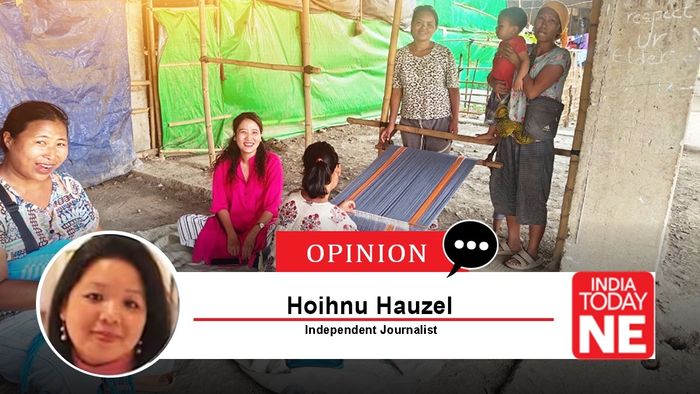Weaving Amidst Mourning: A Quiet Revolution in Churachandpur
In Kuki-Zo culture, weaving isn’t just economic—it’s spiritual. Patterns passed from mother to daughter carry identity, history, and healing. “Our woven pieces hold stories,” Jessica says. “They keep us connected, especially when the world around us changes so fast.”

- May 09, 2025,
- Updated May 09, 2025, 5:46 PM IST
Every morning, Jessica H. Vaiphei wakes with the same question: Which camp should I visit first?
Her days begin not with routine, but with resolve—carrying bundles of yarn through the town of Churachandpur in Manipur’s Churachandpur district, gathering woven goods, and checking in on women who have turned to weaving to reclaim a sense of purpose. She’s not backed by a large organisation or campaign. In fact, she isn’t backed by anyone but herself and a belief that she “can do it.”
She’s just one young woman, navigating taxis, narrow roads, and the deep emotional undercurrents of a post-conflict world—determined to help, however she can.
Her story began long before the crisis.
Born in Churachandpur, Jessica left as a child when her parents—both government employees—were transferred to Imphal. She grew up in New Checkon, a prominent colony inhabited by an eclectic group from the Kuki-Zo communities pressed between Meitei neighbourhoods near the Palace Gate. Life took her into the world of digital content where she wrote and managed websites, freelancing for firms. After her parents retired the family moved back to Churachandpur, her birth place in 2022.
Then came May 3, 2023 where everything changed. An unprecedented conflict erupted between the Kuki-Zo community and the Meiteis, the dominant group residing primarily in the valley. What followed was not just violence, but a deep and lasting rupture. Over 60,000 people and more were displaced, and the state is now left scarred by a stark geographical and communal divide between the hills and the valley — one that remains unresolved to this day.
By February 2024, nearly a year after the unrest had displaced thousands, Jessica was volunteering with Highland Impact Foundation. One day, while documenting conditions at Lanva TD Relief Camp, five minutes’ drive from Churachandpur, something shifted. This particular relief camp has over 400 inmates as of today. She wasn’t just an observer anymore. She was hearing the same ache in every woman’s voice—stories of waiting, of watching time pass without work, of needing to provide but having no means to do so.
That same evening, moved by the weight of the stories she had heard, Jessica pulled Rs 5,000 from her wallet and placed an order for a full backstrap loom set from a local artisan. “It took two days to get it ready,” she recalls. She then bought yarn, returned to the camp, and handed it all to a woman who still carried the skill of her ancestors in her hands. What came back to her wasn’t just fabric but a beginning, a way forward born from tradition, resilience, and the power of belief.
What began as a small, personal gesture has grown into a grassroots weaving initiative reaching across relief camps in and around Churachandpur town.
Also Read: Reviving the heartbeat of Bodo culture: The essential role of festivals in Sifungs’ survival
As of February, there are 98 camps—down from a peak of 130—but still home to thousands of displaced families. Jessica now works with women in these camps, reaching a portion of the estimated 10,000 who remain in limbo. Many of them were once the backbone of their households.
Most days, Jessica moves through town on her own. Occasionally, a family member gives her a lift, but more often, she hails a taxi—arms loaded with yarn to distribute or handwoven products to collect. From one camp to another, she gathers shawls, cushion covers, and table runners—some sold in their traditional form, others reimagined for a modern market.
Social media has become her makeshift storefront, but building a reliable customer base and keeping the momentum going is an ongoing struggle. Still, she’s determined. Jessica believes that with the right market linkages, this grassroots effort could grow into a sustainable business model—one that not only empowers displaced women, but preserves cultural heritage along the way.
Behind her calm determination lies doubt. “There are times I feel like giving up,” she says. “When things stall, I don’t blame others—I ask myself why I can’t even do this properly.” But she keeps going, powered by what she sees in the women she works with: skill, strength, and a hunger for dignity.
In Kuki-Zo culture, weaving isn’t just economic—it’s spiritual. Patterns passed from mother to daughter carry identity, history, and healing. “Our woven pieces hold stories,” Jessica says. “They keep us connected, especially when the world around us changes so fast.”
Yet the project is stretched. A single backstrap loom costs Rs 2,500. She needs dozens more. Yarn, natural dyes, proper packaging, and fair exposure are all in short supply. Training materials, workspace, transport—all of it adds up. She’s not asking for charity, she’s asking for partnership, for backing a community that’s trying to stand again on its own feet.
“When a woman earns,” she says, “her children benefit most. That’s what I hold on to. That’s what keeps me going.”
Meanwhile, the crisis in Manipur remains far from resolved. Although large-scale violence has eased, the situation on the ground is still tense and deeply divided. President’s Rule was imposed in February, symbolising the depth of the political deadlock. A handful of dialogues have taken place between the two communities and the central government, but no meaningful resolution has emerged.
Peace feels distant, almost abstract. Yet amid this prolonged uncertainty, it is individuals like Jessica who bring a glimmer of hope—reminding us that even when systems falter, small, determined acts of an individual can make a difference.